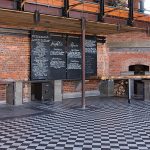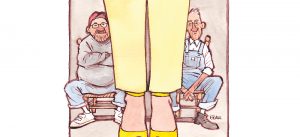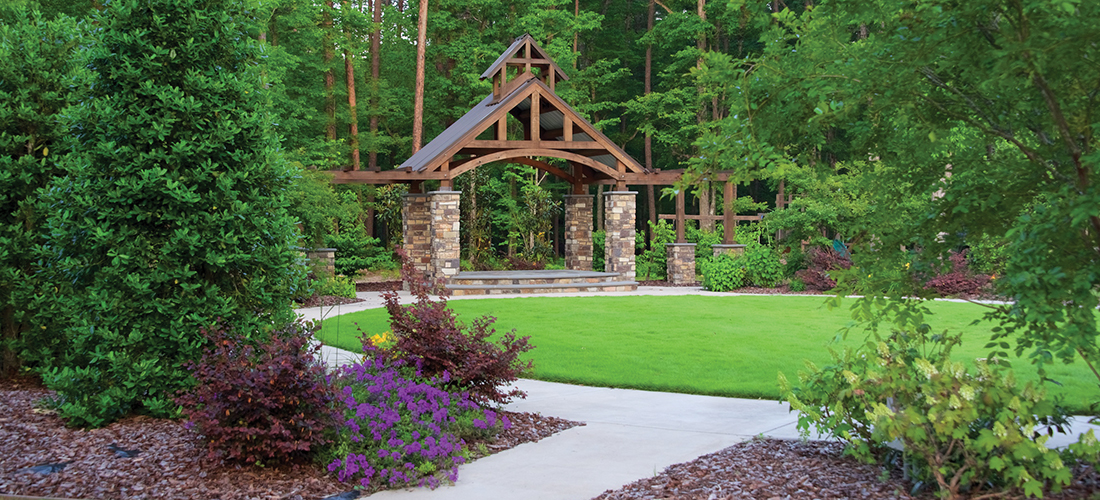
Richard Petty’s homage to the love of a lifetime
By Ross Howell Jr. • Photographs by Lynn Donovan
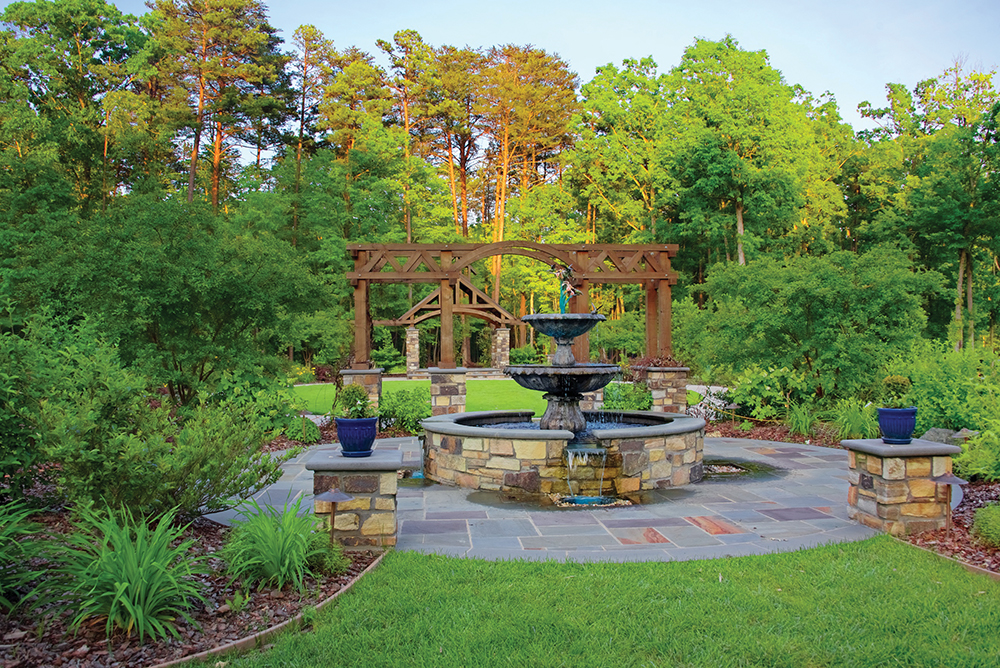
Imagine a love story.
Let’s say it begins in 1958, when a 21-year-old man marries his 17-year-old sweetheart and sets out to make his mark in the world. He wins fame and fortune in a dangerous game, his wife and children by his side. In time, our hero and his bride suffer setbacks and even tragedy. But these challenges make their ties to family even stronger.
Then, in 2014, the man loses his sweetheart to cancer. With children and grandchildren gathered, she passes away peacefully at the home the couple had built together.
So we close our romance and reach for the tissues, right?
Not Richard Petty.
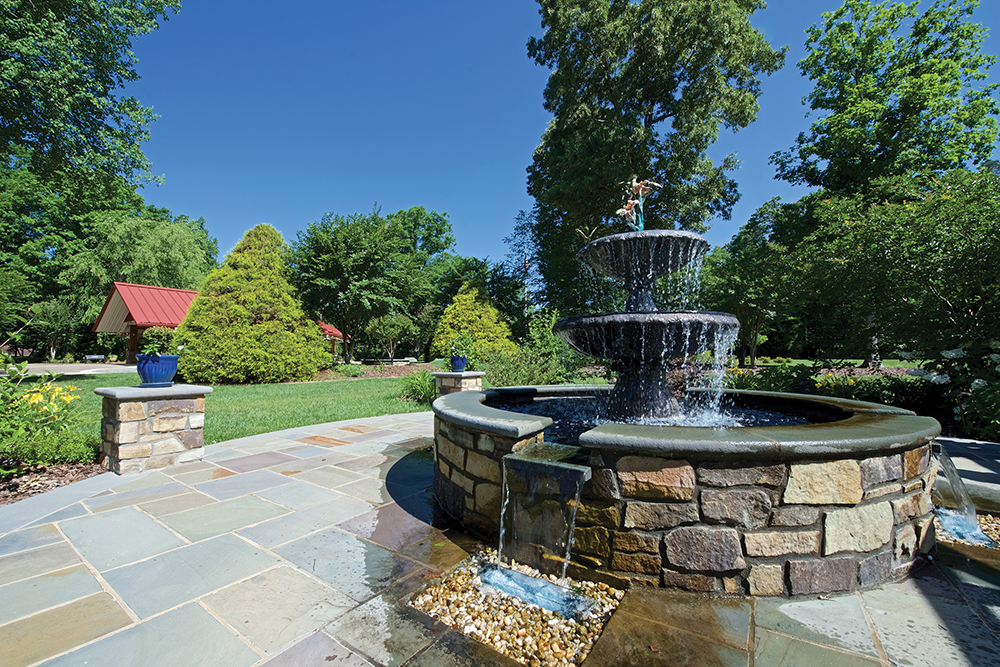
Instead, one fine morning, after talking with his children, he walks out in the fields of the farm where he’s lived with his wife for 40 years and picks a spot to create a garden in her memory. A place he’ll fill with living things, where people can gather to celebrate and pray.
And that’s why I happen to be driving through Level Cross toward Randleman. I turn on to Providence Church Road, looking for the gate guards for the drive into “Reverie Place,” Petty’s 528-acre estate. I pull in, passing the brick guards with their black metal gates, a handsome gold “P” glistening on each one.
There’s a fenced pasture to my right and woodlands to my left. Ahead there’s another set of gate guards. Beyond them is a flagpole, an American flag stirring in the breeze. Lion sculptures stand post at the guards below a vigilant eagle and a pineapple, symbol of hospitality.
The drive forks, curving to the right toward a big, low-slung brick house shaded by oaks, or straight ahead toward fenced pastures and a horse barn. That’s where I spot O.Henry photographer Lynn Donovan and her husband Dan speaking with someone.
I park the car and Lynn introduces me to Rebecca Petty Moffitt, the youngest of the four Petty children. She serves as executive director of the Petty Family Foundation and has agreed to show us around the property today.
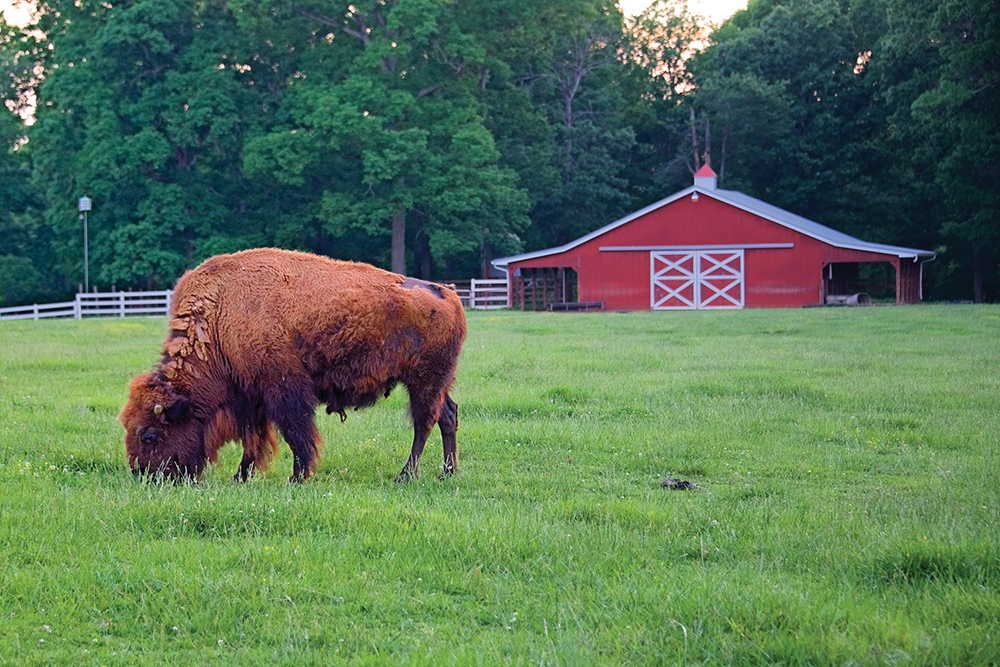
My attention is captured right away by a fountain opposite the drive. In its play of water are sculpted hummingbirds, some flying, some at rest. The fountain stands in the center of a circular basin of stone.
“The artist did four different hummingbirds to represent us children,” Moffitt tells me. “The fountain is the only place where you’ll find all four of them together.” A sign on a low stone wall lets me know this is the spot Petty and his children picked to honor their wife and mother.
The sign reads, “The Lynda Petty Memorial Garden.”
A circular walk around the fountain leads to an arched wooden bower set on stone foundations. Nearby are big stones with plantings of holly, hydrangeas and day lilies.
“Momma was a real gardener,” Moffitt says. “Vegetables, fruits, flowers, you name it. Daylilies were her favorites.”
As I look up at the bower, Moffitt explains that the structure was built to suggest the narthex of a church. Southern Pines landscape designer Mark Wesley Parson, a family friend, helped with the design of the garden.
I step through the narthex into an open circle of manicured lawn, perhaps a hundred feet in diameter. Bordering the circle are more plantings — crepe myrtle, Mexican sage, butterfly bush, white hydrangea, holly and more.
Straight ahead is another wooden structure built on stone footings. It rises to a peak, and above is the shape of a bell tower. I turn to Moffitt.
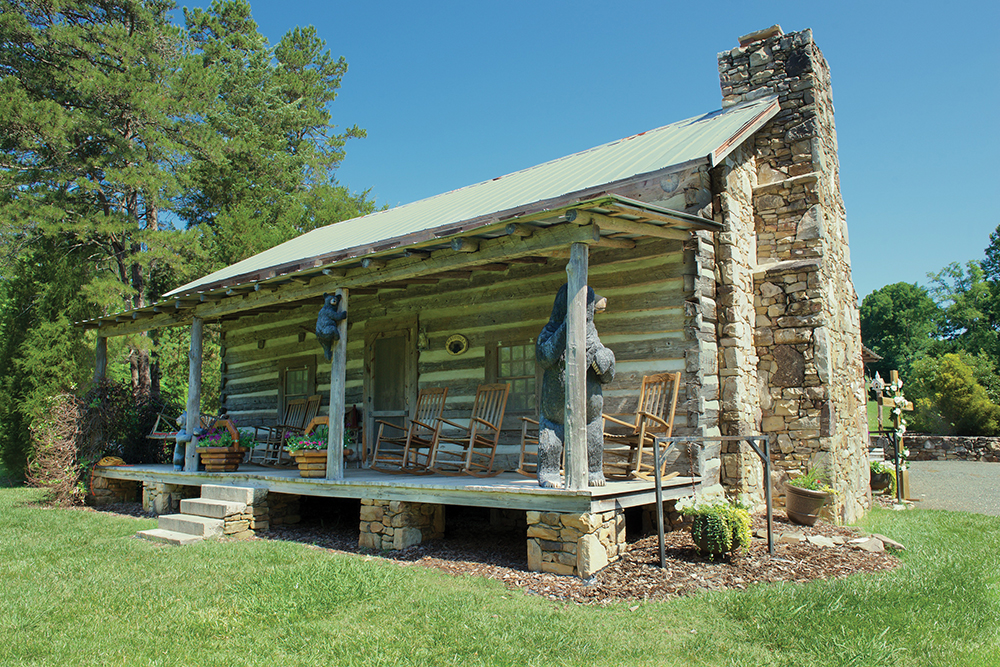
“The altar?”
She nods. There are wings, with plenty of room for wedding attendants.
I take a moment to enjoy the quiet here — a sanctuary carpeted with grass, walled in by living things, vaulted by the sky above. A good place for a soul to linger. The wind sighs in the pine woods beyond the altar.
“Mark wanted the design to direct you forward,” Moffitt says, “and up.”
“I see that,” I say. “It’s a beautiful spot.”
“Two of my nieces were married here,” she says. “You wouldn’t expect it, but inside the circle we can seat 150 people.”
And that’s where our love story takes a turn toward the practical.
Five hundred acres is a lot to keep up, and Richard Petty wants his estate to be self-sustaining financially. While he’s given 100 acres to Victory Junction, the camp for children with chronic or serious illnesses founded in honor of his grandson, Adam, there are still four people who work full time to maintain the place.
“Daddy’s proud of the success he’s had,” Moffitt says. “And he likes sharing it with people, having people on the property.”
So the family came up with the idea of making Lynda’s memorial garden and other places on the Petty farm available for weddings and other celebrations. They developed a website, www.reverie-place.com, where a variety of options for uses of the property, April through October, can be found.
“One weekend we had two formal weddings with big receptions,” Moffitt says. “Honestly, it was just too hectic.” They’ve learned in spite of demand, they need to limit the number of activities they book.
Down the hill from The Lynda Petty Memorial Garden is a pasture fence and just beyond, a trim horse barn.
“Oh, we have brides who’ll prefer something more casual,” Moffitt says. “Something country.” So staff at the farm will decorate the barn and put straw bales out for people to sit.
“We’ve had several weddings there,” Moffitt says.
We turn and head toward the Pavilion. As I drove in, I missed seeing a large stone fire pit with metal benches.
“This is a great spot for making s’mores,” Moffitt says.
The Pavilion is large, with a metal roof, and wooden, cantilevered supports set on stone footings.
“It’s a great place for receptions, parties, showers, company events,” Moffitt says. Canvas sides can be lowered if the weather is rainy or cold. White tables and chairs are still in place from an earlier event.
Moffitt tells me the Pavilion was built on what used to be the family tennis courts.
“This was such a great place to grow up as a kid,” she says, smiling. “We were always doing something, riding four-wheelers in the woods, whatever.”
Tall crepe myrtles line one side of the Pavilion. On the other side is a water garden shaded by big hardwoods. Water spurts from the trunk of a happy elephant sculpture into a two-stage spillway before splashing into a pool. There are cattails, horsetails, water lilies, hostas and rhododendrons. There are frog and heron figures. The sound of the water is soothing, tranquil.
We’re close to the Petty residence, and I notice here and there are painted hot-air balloon sculptures, metal bicycle sculptures, frogs and huge planters.
“Oh, that’s Daddy,” Moffitt says. “Sometimes he gets a little carried away.”
She smiles broadly. She tells me her father likes to look through direct mail catalogs, and when he orders something, he orders plenty.
“To tell you the truth,” she continues, “we try to get to his mail before he does, so we can pull out all the catalogs!”
As we’re looking at the Pavilion and water garden, we’re joined by Moffitt’s sister, Sharon Petty Farlow, executive director of the Petty Museum in Randleman and the event coordinator for Reverie Place. A kindergarten and elementary school teacher for 32 years, Farlow serves on the Randolph County School Board, just as her mother did.
Farlow is driving a golf cart, and asks us to hop on so we can ride down to see another attraction on the estate. We travel along a drive lined with cherry trees.
“They’re so pretty in the spring,” Farlow says. Like her sister, she has a wide, bright smile, and laughs easily.
“They alternate,” she continues, “one with white blossoms, the next with pink.”
We start down a slow grade, the road bending to the left. On that side beyond a pasture fence is a grove of oaks in a pasture. I see a couple of bison and a donkey.
“Daddy has longhorn cattle somewhere in the pasture,” Farlow says. “And peacocks at the barn. He always has something.” She tells me how she’ll sometimes see her father out in the fields in the early morning, looking things over.
Above the drive I glimpse a small grape arbor with apple trees beyond.
“Momma had those trees put in,” Moffitt says. “She loved making her pies.”
We start down the grade. Straight ahead lies a wide expanse of mown grass with a big pond stretching to an earth dam. A gentle point of land juts into the pond. There’s open pasture to the left, and river birches and woodlands to the right.
We pull into a circular drive next to a log cabin.
Farlow parks the cart and we pile out. The pond has a big aerator. We listen to the water. Spray refracts into little jewels in the sunlight. It’s a peaceful spot.
“Daddy had this cabin moved here,” Farlow says. “It dates from the 1800s. There was a barn attached, and he moved it, too. That’s where the kitchen and bath were put in.”
I comment on the johnny house behind the cabin, and Farlow chuckles.
“It’s actually a Porta-john for outdoor events,” she says. “We boarded it over for effect.”
We walk around to the front of the cabin, where a porch overlooks the pond. Big bears, carved by an artist in Wyoming, stand watch. We climb the steps and go inside the cabin, blinking at the change from bright sunlight.
Around us are antiques, racing memorabilia and quilts. A massive stone fireplace reaches from floor to ceiling. There’s an antique pie safe, a wooden ice box, and a “Country Charm” reproduction woodstove in the kitchen.
“At one time, Momma owned an antiques shop,” Farlow says. “Daddy always said the problem with the shop was Momma was its best customer.” Her bright smile flashes.
I step up a narrow stairway to a loft, where there’s a metal frame bed, quilts and antique dolls. I look down onto the main floor. The two sisters haven’t seen each other in days, so they’re sitting together, chatting about children and schedules and relatives. The sound of their voices is musical, comforting.
I step back to the main floor. The two sisters stand.
“Sometimes brides like to put on their gowns here,” Moffitt says. “Where it’s nice and quiet.” She tells me there’s a bower they can set up on the point of land by the pond. Several brides have had their weddings there. Sometimes people will rent the cabin for a weekend getaway.
“I’ll lock up behind you,” Farlow says. Moffitt and I start for the porch. By the window is a big round table. Moffitt stops for a moment.
“We brought that table from the house,” she says quietly. She tells me how the Petty family’s life in racing meant a life of weekends on the road.
“But on Tuesday nights,” Moffitt says, “Daddy would be home, with all of us, and Momma would always fix beans and cornbread.” She tells me about sitting around the table with her brother and sisters, with her mother and father. I can hear in her voice how special those meals were.
We walk out onto the porch and down the steps. I hear the door lock behind us. We step around to the golf cart as Farlow closes and locks the side door to the cabin.
She gets behind the wheel of the cart.
“There’ve been so many events for Daddy’s birthday,” Farlow says. “You know, sponsors, friends, fans. And family. He turned 80 in July.”
Moffitt smiles at her sister as the cart starts up the grade. Then she looks at me.
“I said to him, ‘Daddy, you keep going to all these events, you’re gonna wind up being 200 years old!’” We all laugh together.
As we pass the curve where Lynda Petty’s arbor and trees overlook the drive, across from the pastures where Richard Petty likes to walk alone in the mornings, I get the feeling the love story we imagined at the beginning of this piece isn’t over quite yet. OH
When Ross Howell Jr. was a student at Floyd County High School in Virginia, stock car driver Curtis Turner was a hometown hero, the Wood Brothers were building race cars with their father Glen in nearby Stuart, and Richard Petty was on his way to becoming a legend.

